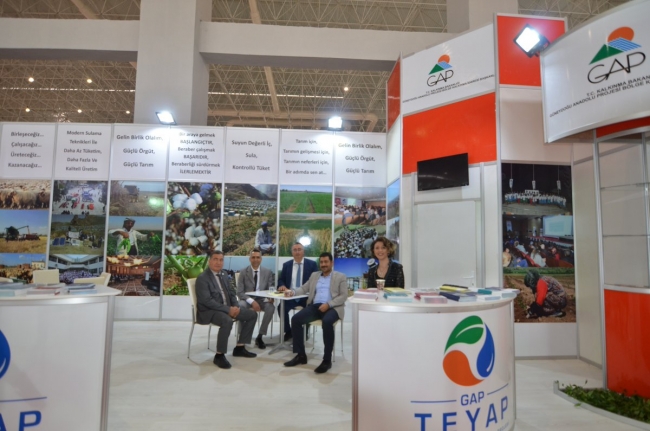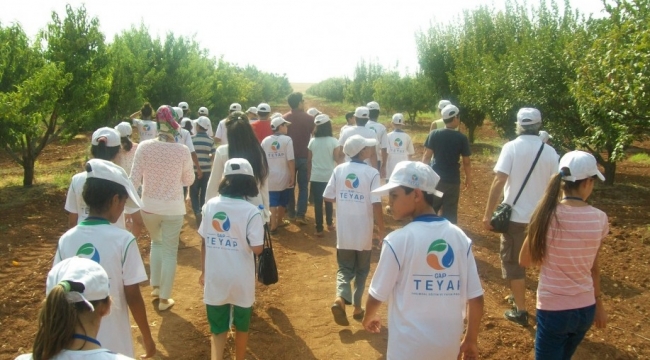 Justification: In the context of improving agricultural training and extension services the project was launched in 2011 under the coordination of the Ministry of Development GAP Regional Development Administration (GAP-RDA). The project envisages introducing solutions to problems confronted in agriculture in the region and ensuring sustainable development in agriculture by efficient utilization of natural resources and potentials of the region.
Justification: In the context of improving agricultural training and extension services the project was launched in 2011 under the coordination of the Ministry of Development GAP Regional Development Administration (GAP-RDA). The project envisages introducing solutions to problems confronted in agriculture in the region and ensuring sustainable development in agriculture by efficient utilization of natural resources and potentials of the region.
Goal 1: Mobilizing farmers’ organizations for the delivery of training and extension services that farmers need particularly in areas already under irrigation and others soon to be brought under irrigation.
Goal 2: Strengthening of farmers’ organizations in administrative, financial and technical terms to enable them to undertake the delivery of sustainable and effective extension and counselling services
Goal 3: Building awareness in organizing and group forming necessary for utilizing potentials in relevant areas and encouraging new forms in agricultural organization that is in compliance with the goals and objectives of GAP-TEYAP Stage III (Sustainability).
Objective: Accelerating rural development.
Activities Conducted: The GAP-TEYAP was given start in 2011 to improve and close gaps in training and extension services in areas under irrigation. The project is implemented together with relevant institutions under the coordination of GAP-RDA. The project has three stages.
I. Stage - Training-Extension
II. Stage - Extension Model
III. Stage - Sustainability

I. Stage (2011 – 2013)
Activities at this stage were planned and implemented to contribute to capacity building in relevant institutions and farmers’ organizations, to ensure coordination and awareness building and to develop an extension model fit for the region.
A Pluralistic Extension Model was developed at this stage that took farmers’ organizations as its centre. Also, thematic working groups were created (Irrigation, Organization, Good-Organic Farming, Beekeeping and Plant Nutrition).
II. Stage (2014-2016)
In line with the objectives and targets of the implementation plan, this stage of the project was marked by the creation of new farmers’ organizations in the region and improvement and strengthening of these organizations in administrative and technical terms so as to enable them to deliver extension and counselling services. In this period 4 new farmers’ organizations (Gaziantep Şehitkâmil Cherry Farmers’ Union, Batman Sason Strawberry Farmers’ Union, Adıyaman Kâhta Achene Farmers’ Union, Dicle Organic Fruit Farmers’ Union) were established with the contribution and support of GAP-TEYAP and activities were carried out with 33 farmers’ unions.
Further, 11 different model projects and activity programmes were developed for the purpose of ensuring sustainability. 3 of these projects (Şanlıurfa Suruç Collective Machine Park, Batman Sason Strawberry Complex and Batman Gercüş Training Ranch) were given direct support and the GAP-TEYAP was registered as trademark.
III. Stage (2017-2018)
This stage aimed to demonstrate how the principle of self-help can be translated into life in training, extension and counselling services in newly established farmers’ organizations and to create model implementation centres. In the context of ensuring sustainability, the “Local Crop Processing Facility Project” in Midyat District of Mardin Province was supported in 2017.
As of 2018 the GAP-TEYAP is working with 48 farmers’ organizations including 26 chambers of agriculture, 11 growers’ unions, 8 farmers’ unions and 3 irrigation unions. In addition to these there are 6 irrigation areas where work is presently going on for efficient water use and preparation for irrigation. (Diyarbakır-Pamukçay Irrigation Area, Dicle Kralkızı Part III. Irrigation, Şanlıurfa Suruç Pumped Irrigation Area, Gaziantep Belkıs-Nizip Irrigation Area, Adıyaman Samsat Irrigation Area and Şanlıurfa Günışığı Irrigation Area)


















